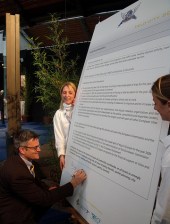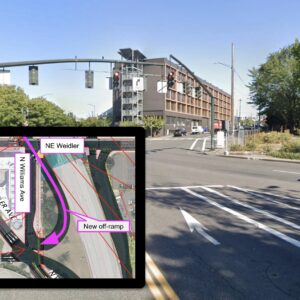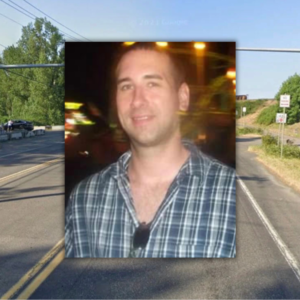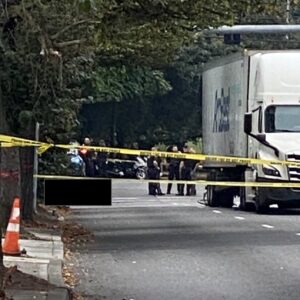
would figure so prominently in
Portland’s Bicycle Plan?
(Photo: Greg Raisman)
Benchmarks are important in order to know whether or not a plan is successful, especially when a plan — like the Portland Bicycle Plan for 2030 — has a 20-year horizon. That plan has a highly-publicized goal of 25% of all trips by bike by the year 2030. But what about near-term benchmarks, which can be useful to make sure a plan is headed in the right direction?
Back in November, the Bicycle Transportation Alliance (BTA) expressed concern that the City of Portland’s Public Comment Draft of the Bicycle Plan for 2030 had no near-term benchmarks whatsoever.
In their official comments on the plan, the BTA wrote, “We will not know if the City has succeeded or failed to complete this plan until the year 2030. This makes any corrective action impossible if the City is not following the plan.”
The BTA also suggested some benchmarks the City could adopt and include in the plan. Those benchmarks included “130 miles (of new bikeways) by 2013,” “Two Trails by 2020 (completion of Sullivan’s Gulch and North Willamette Greenway Trails)”, and my favorite, “20% (of all trips by bike) by 2015”.
In the final version of the Bicycle Plan released last week, the City ignored all of the BTA’s suggestions — but they didn’t ignore benchmarks completely.
In the final version of plan, the City expanded the “Bikeway network evaluation” section (5.5.2) by several pages, but they stopped short of any specific benchmarks of their own. Instead, they wrote that the plan simply, “recommends the further development of performance measures and benchmarks for bicycling.” They also included a lengthy description (with no actual numbers attached) of performance measures broken down into seven general themes.
I asked Bicycle Plan project manager Ellen Vanderslice why they stopped short of definitive performance measures. She said the idea needs more “consensus”. “We looked at some of the benchmarks that were proposed, but without a baseline it’s kind of hard to figure out how you’re going to do the benchmarking.” On that note, Vanderslice said coming up with more benchmarks is listed as one of the plan’s many Action Items (which have no dedicated funding or timeline for completion).
“The process is unfinished and I hesitated to slap down some things for the sake of having benchmarks when we hadn’t been through a thorough enough process.”
There are near-term benchmarks in our existing Bike Master Plan, Vanderslice pointed out, but they didn’t really have much teeth. “Benchmarks are great, but if you have them and don’t meet them so what?… There doesn’t seem to be anyone saying [about existing benchmarks], ‘oh my gosh!’ when you don’t meet them… That doesn’t exactly happen, so what do they really give you?”
However, instead of coming up with their own benchmarks, or adopting the BTA’s ideas, the City did choose to include two benchmarks in their Bicycle Plan from an unlikely source: The Charter of Brussels. Signed by Mayor Sam Adams during his visit to the Velo-City conference back in June, that charter commits the City to:
- At least 15 percent of all trips by bicycle by the year 2020
- Risk of a fatal bicycle crash reduced by 50 percent by the year 2020
Those might have come from an unlikely place, but a benchmark is a benchmark. So, the question now is, will we be at 15% mode split in 10 years? And if we aren’t, will anyone remind the City about their commitment?






Thanks for reading.
BikePortland has served this community with independent community journalism since 2005. We rely on subscriptions from readers like you to survive. Your financial support is vital in keeping this valuable resource alive and well.
Please subscribe today to strengthen and expand our work.
Where will our esteemed Mayor be, come 2020. Or any of the endorsers of this “Bike Plan”.
And so it goes, and so it goes! How about today, this week, this month?
They are working around Sandy and Burnside!
David
The reason for the plan is to establish continuity on a greater time scale than the revolving door of leadership. In that vein, The Bicycle Master Plan is not intended to provide daily, weekly or monthly specifics.
Likewise the plan does not provide the schedule for the current Mayor 10 years from now.
@ #1 –
Whilst I agree with you…Sandy and Burnside are dog-awful nightmares for cars, much less bicycles and pedestrians, I think it’s more cost-effective for PBoT to focus funding on the suitable cycling alternatives that are less-frequented by automobile traffic.
Sandy and Burnside will always be heavily used by 18-wheelers, in which case whatever infrastructure they throw at it will simply be ruined and rendered ineffective in 2 years of those monsters destroying it. The ruts in Burnside are nearly 6 inches deep between NW 23rd and the Burnside Bridge. I don’t know what they could do there to make it more bicycle-friendly!
and yet I see people cycling on Burnside and Sandy all the time.
Cycling will never be mainstream in Portland until the main streets are cyclist-friendly.
Oh no doubt, BURR…brave souls they are, to the extent of stupidity in some cases. 🙂
Portland is the only place I’ve lived where people have a strong feeling that bikes don’t belong on certain roads. Everywhere else, where there are much smaller bicycle road networks, every road is a bike route for better or worse.
This sort of approach has worn on me, when I see a cyclist on MLK or Burnside now, I become fearful FOR them. That’s not the right attitude, especially when these roads are some of the most efficient and tend to have many businesses on them.
That’s one asset of the BMP2030 — it identifies the need for proper facilities on these major streets. It’s where people want to go, not avoid.
Steve B,
I couldn’t agree with you more. I mentioned Burnside and Sandy with regard to David #1’s comment about “today, this week, this month” in that those roads would take til 2030 to “fix” (if they ever “fix” them).
“Benchmarks are great, but if you have them and don’t meet them so what?… There doesn’t seem to be anyone saying [about existing benchmarks], ‘oh my gosh!’ when you don’t meet them… That doesn’t exactly happen, so what do they really give you?”
Wow. Say no more.
Please update this story when PBOT reaches a consensus on imaginary goals and performance suggestions.
I don’t think Portland city government particularly likes being held to any actual promises of results, because that makes it easier just to forget that all the things the city likes to spend money on and all the people it likes to give sweetheart deals to aren’t really paying off. Jarrett Walker has a really interesting and sobering look at how far Portland’s transit promises are from reality.
Look at SoWa — the rhetoric: supposed to be the epicenter of biotech, bringing hundreds/thousands of new jobs to Portland; the reality: a bunch of half-empty condo towers.
Sigh.
@#5…Since I take Sandy from about 52nd down to, through, and onto Burnside several times a week, around morning rush hour, I wonder if I need to have my IQ reevaluated.
Rather than stupidity, I prefer to consider it a childlike faith in humans’ better nature. Although I often hear an engine revving higher as a car passes me than strictly necessary, I almost never feel actual danger.
Perhaps we become inured to the sense of risk as we follow a path repeatedly. I remember being terrified of taking Greeley from Going to Interstate as I first followed my lovely and intrepid GF into town from St Johns. But with time those UPS trucks don’t really bother me that much. (Introspection about IQ test is repeated here.)
BTW, Ellen’s point about benchmarks is an instructive one. The Bicycle Master Plan adopted in 1996 and updated in ’98 lists these:
in 10 years – increase Inner Ptld bike mode share to 10%, whole city bike mode share to 6%, bike/motor vehicle crashes reduced by 10%;
in 15 years – Inner Ptld bike mode share to 15%, whole city to 10%; bike/motor vehicle crashes reduced by 20%.
Come to think of it, you don’t hear a lot because we largely achieved our 10 year goals. Nevermind.
el timito # 11 –
I apologize. I didn’t mean to call anyone “stupid”, including you.
It was a small quip from my Army days designed to keep soldiers from being so brave we get ourselves killed.
Keep cycling and making a point to the cars, indeed. We will win this race.
🙂